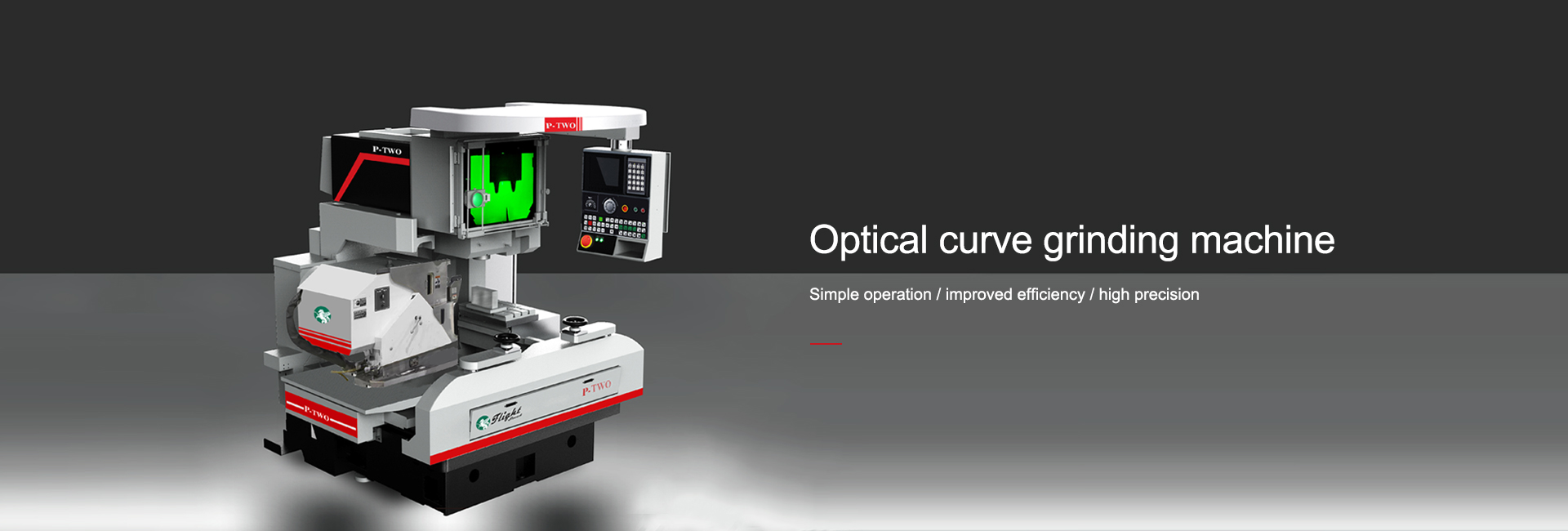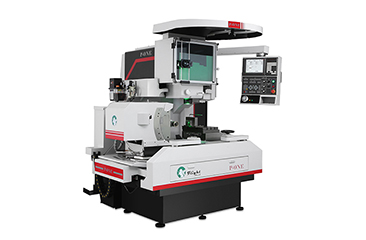

The grinding wheel is an indispensable tool in grinding processing. Whether the grinding wheel is selected properly or not is an important condition affecting the grinding quality and grinding cost. Our company produces a series of curve grinding machines, which need to be equipped with different grinding wheels to adapt to the curve processing of various workpieces. To facilitate users' targeted selection of grinding wheels, this article summarizes the selection of grinding wheels for curve grinding machines and the common choices of grinding wheels for different workpiece materials, for your reference.
There are many types of grinding wheels, and they come in various shapes and sizes. Due to the different abrasive materials, binder materials and manufacturing processes of grinding wheels, different types of grinding wheels have different working performances. Each type of grinding wheel has a certain range of applications based on its own characteristics. Therefore, during grinding operations, it is necessary to select the appropriate grinding wheel based on specific circumstances (such as the material properties of the workpiece being ground, heat treatment methods, workpiece shape, size, processing form and technical requirements, etc.). Otherwise, the improper selection of grinding wheels will directly affect the processing accuracy, surface roughness and production efficiency. The following are the basic principles for selecting grinding wheels for your reference.
I. Selection of Ordinary Grinding Wheels
The selection of grinding wheels mainly depends on the material of the workpiece and the heat treatment method.
When grinding materials with high tensile strength, abrasives with high toughness should be selected.
When grinding materials with low hardness and high elongation, brittle abrasives should be selected.
When grinding materials with high hardness, choose abrasives with even higher hardness.
D. Select abrasives that are less likely to undergo chemical reactions with the processed materials.
The commonly used abrasives are brown corundum (A) and white corundum (WA), followed by black silicon carbide (C) and green silicon carbide (GC). Other commonly used ones include chromium corundum (PA), single crystal corundum (SA), microcrystalline corundum (MA), and zirconium corundum (ZA).
Brown corundum grinding wheel: Brown corundum has high hardness and great toughness, making it suitable for grinding metals with high tensile strength, such as carbon steel, alloy steel, malleable cast iron, hard bronze, etc. This abrasive has good grinding performance, wide adaptability, and is often used for rough grinding to remove large allowances. It is inexpensive and can be widely used.
White corundum grinding wheels: The hardness of white corundum is slightly higher than that of brown corundum, but its toughness is lower than that of brown corundum. During grinding, the abrasive grains are prone to breakage, so the grinding heat is small. It is suitable for manufacturing grinding wheels for precision grinding of quenched steel, high-carbon steel, high-speed steel, and grinding of thin-walled parts. However, its cost is higher than that of brown corundum.
Black silicon carbide grinding wheel: Black silicon carbide is brittle and sharp, with a higher hardness than white corundum. It is suitable for grinding materials with lower mechanical strength, such as cast iron, brass, aluminum and refractory materials, etc.
Green silicon carbide grinding wheels: Green silicon carbide has higher hardness and brittleness than black silicon carbide. Its abrasive grains are sharp and it has good thermal conductivity. It is suitable for grinding hard and brittle materials such as hard alloys, optical glass, and ceramics.
Chromium corundum grinding wheels: Suitable for grinding tools, measuring tools, instruments, threads and other workpieces with high surface processing quality requirements.
Single crystal corundum grinding wheels: Suitable for grinding materials with high toughness and hardness such as stainless steel and high-vanadium high-speed steel, as well as workpieces that are prone to deformation and burning.
Microcrystalline corundum grinding wheels: Suitable for grinding stainless steel, bearing steel and special ductile iron, etc., used for form grinding, entry grinding and mirror grinding.
Zirconia corundum grinding wheels: Suitable for grinding austenitic stainless steel, titanium alloys, and heat-resistant alloys, especially for heavy-duty grinding.
The selection of particle size mainly depends on the surface roughness of the workpiece to be ground and the grinding efficiency.
Particle size refers to the particle size of the abrasive, and its size is indicated by the particle number. When grinding with coarse-grained grinding wheels, the production efficiency is high, but the surface of the ground workpiece is relatively rough. When grinding with fine-grained grinding wheels, the surface roughness of the ground workpiece is relatively good, but the production rate is relatively low. Under the premise of meeting the roughness requirements, coarse-grained grinding wheels should be selected as much as possible to ensure a higher grinding efficiency. Generally, coarse-grained grinding wheels are selected for rough grinding, while fine-grained grinding wheels are chosen for fine grinding.
When the contact area between the grinding wheel and the workpiece is large, a grinding wheel with a coarser grit should be selected. For example, when grinding the same curve, the grit size selected for grinding the end face of the grinding wheel is coarser than that for grinding the periphery of the grinding wheel.
The selection of hardness mainly depends on the material of the workpiece to be ground, grinding efficiency and the quality of the machined surface.
Hardness refers to the ease with which abrasive grains of a grinding wheel fall off under the action of an external force. To meet the requirements of grinding different workpiece materials, grinding wheels are classified into different hardness grades when manufactured.
If the grinding wheel is selected to be too hard, the blunted abrasive grains are not easy to fall off, the grinding wheel is prone to clogging, the grinding heat increases, the workpiece is prone to burning, the grinding efficiency is low, and it affects the surface quality of the workpiece. If the grinding wheel is selected too soft, the abrasive grains will fall off while they are still sharp, increasing the wear of the grinding wheel, making it easy to lose the correct geometric shape and affecting the accuracy of the workpiece. Therefore, the selection of grinding wheel hardness should be appropriate. It should also be comprehensively considered based on factors such as the size of the contact area between the grinding wheel and the workpiece, the shape of the workpiece, the grinding method, the cooling method, and the type of binder used in the grinding wheel.
The following principles for selecting grinding wheel hardness are for reference:
When grinding soft materials, a harder grinding wheel should be selected; when grinding hard materials, a soft grinding wheel should be chosen.
When grinding soft and highly tough non-ferrous metals, the hardness should be selected to be softer. c. When grinding materials with poor thermal conductivity, a softer grinding wheel should be selected.
D. When end face grinding is used compared to circular grinding, the hardness of the grinding wheel should be selected to be softer.
Under the same grinding conditions, the hardness of resin-bonded grinding wheels is 1 to 2 minor grades higher than that of ceramic-bonded grinding wheels.
When the rotational speed of the grinding wheel is high, the hardness of the grinding wheel can be selected as soft 1 to 2 grades.
The hardness of the grinding wheel used in coolant grinding is 1 to 2 grades higher than that in dry grinding.
4. The selection of the binder should be taken into account based on conditions such as the grinding method, usage speed and surface processing requirements.
The commonly used grinding wheel binders include ceramic binder (V) and resin binder (B).
Ceramic binder is an inorganic binder with stable chemical properties, good heat resistance and corrosion resistance, and a large porosity. Grinding wheels made with this binder have high grinding efficiency, low wear, and can better maintain the geometric shape of the grinding wheel. It has a wide range of applications. It is suitable for grinding common carbon steel, alloy steel, stainless steel, cast iron, cemented carbide, non-ferrous metals, etc. However, ceramic-bonded grinding wheels are relatively brittle and cannot withstand severe vibration. It can generally only be used at a speed of 35 meters per second or less.
Resin binder is an organic binder. Grinding wheels made with this binder have high strength, certain elasticity, low heat resistance, good self-sharpening property, simple production and short process cycle. Grinding wheels with a working speed higher than 50 meters per second and very thin grinding wheels can be manufactured. Its application scope is second only to ceramic binders and is widely used in rough grinding, rough grinding, cutting and free grinding, such as grinding steel ingots and deburring castings. It can manufacture high-speed and high-gloss grinding wheels, as well as grinding wheels for heavy-duty, cutting and various special requirements.
5. The selection of the organization mainly takes into account the pressure the workpiece is subjected to, the grinding method, the material of the workpiece, etc.
The structure refers to the percentage of abrasive grains in the volume of the grinding wheel. The classification of grinding wheel structure grades is based on a 62% abrasive grain volume percentage as the "0" grade structure. For every 2% decrease in abrasive grain volume, the structure increases by one grade, and so on. In total, there are 15 grades. The larger the number, the looser the tissue. A tightly organized grinding wheel can produce a better surface of the workpiece. A grinding wheel with a loose structure, due to its large gaps, can ensure that the grinding chips are accommodated during the grinding process and prevent the grinding wheel from getting clogged. When roughly grinding and grinding relatively soft metals, the grinding wheel is prone to clogging.